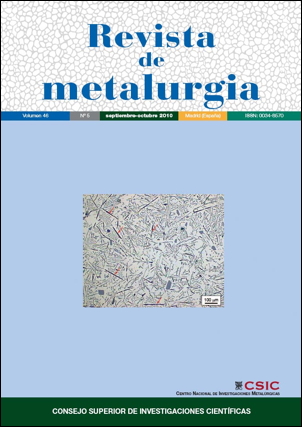Deformability analysis of the AISI 304 DDQ stainless steel under deep drawing multiaxial condition. Evaluation of the initial strain influence
DOI:
https://doi.org/10.3989/revmetalm.0967Keywords:
Formability, Anisotropy, Initial strain state, 304 DDQAbstract
The deep drawing formability of a material is established as a function of standard indexes, as strength coefficient and anisotropy coefficient. But these indexes are determined in different conditions to those that take place in the forming process. The simulative assays do not separate the actions due to the different variables that work in the process, as for example, the rolling direction. In the present work a test that uses a wedge shape die is considered in order to obtain the strength and anisotropy coefficients as a function of rolling direction. This way, the assays are carried out under a tensile-biaxial compression stress state similar to that one taking place in the flange zone in deep drawing. The experimented material is a deep drawing quality stainless steel AISI 304. The influence of initial strengthened states, rolling and uniaxial tensile on the steel behaviour are also studied. The results permits the authors establish the validity of the assay from the point of view of the strains produced in the sheet. The initial strain has a higher effect on the material than that one obtained from the tensile-biaxial of the state than the tensile-biaxial compression causes. The anisotropy coefficient changes with the strain for the sheet rolling direction.
Downloads
References
[1] D. C. Chiang y S. Kobayashi, J. Eng. Ind. (1966) 443-448.
[2] D.M.Woo, J.Mech. Eng. Sci. 2 (1964) 116-131. doi:10.1243/JMES_JOUR_1964_006_021_02
[3] E. Gao, W. Li, H. Kou, H. Changa, J. Li y L. Zhou, Trans. Nonferrous Met. Soc. China 19 (2009) 433-437. doi:10.1016/S1003-6326(08)60291-5
[4] C. García, D. Celentano, F. Flores, J.P. Ponthot y O. Oliva. J.Mater. Proc. Technol. 172 (2006) 461-471. doi:10.1016/j.jmatprotec.2005.11.016
[5] S. Holmberg, B. Enquist y P. Thilderkvist, J. Mater. Process. Tech. 147 (2004) 72-83. doi:10.1016/j.jmatprotec.2003.07.004
[6] J.L.Geoffroy, J.Goncalves y X. Lemoine, IDDRG 2007 Conf., Györ, Hungría, pp.177-180.
[7] L. Kessler,H. Richter, K. Roll yA. Faust, IDDRG 2007 Conf., Györ, Hungría, pp. 101-108.
[8] V. Miguel, J. Benet, J. Coello, A. Calatayud y A.Martínez,Mater. Proc. Design.Model., Simul. Appl. (2007) pp. 823-828.
[9] ASMHandbook. Vol. 14B (2005) pp. 673-696.
[10] S. Rajagopal, J. Eng. Ind. 103 (1981) 197-202. doi:10.1115/1.3184475
[11] L. Gunnarson, N. Asnafi y E. Schedin, J.Mater. Process. Tech. 73 (1998) 89-96. doi:10.1016/S0924-0136(97)00217-3
[12] T. Yagami, K.Manabe y Y. Yamauchi, J.Mater. Process. Tech. (2007) 187-191.
[13] V.Miguel, C. Ferrer y A. Calatayud, Rev.Metal. Madrid 43 (2007) 146-156.
[14] V.Miguel, J. Coello, A. Calatayud, M.C. Manjabacas, A. Martínez y C. Ferrer. J. Mater. Process. Tech. 209 (2009) 1.588-1.596.
[15] J.Coello,V.Miguel,A.Calatayud,C. Ferrer yA. Martínez, Rev.Metal.Madrid 44 (2008) 503-512.
[16] UNE EN ISO 36404:1988 EX.
[17] J. Coello, V. Miguel, C. Ferrer, A. Calatayud y A.Martínez, Rev.Metal.Madrid 45 (2009) 351- 364.
[18] G. W. Rowe, Conformado de los metales, Ed. Hurmo, Bilbao, 1972, pp. 86-95.
[19] N. Kawai, N. Hayashi y S. Matsui, Trans. ASME 110 (1988) 376-383. doi:10.1115/1.3187897
Downloads
Published
How to Cite
Issue
Section
License
Copyright (c) 2010 Consejo Superior de Investigaciones Científicas (CSIC)

This work is licensed under a Creative Commons Attribution 4.0 International License.
© CSIC. Manuscripts published in both the printed and online versions of this Journal are the property of Consejo Superior de Investigaciones Científicas, and quoting this source is a requirement for any partial or full reproduction.
All contents of this electronic edition, except where otherwise noted, are distributed under a “Creative Commons Attribution 4.0 International” (CC BY 4.0) License. You may read the basic information and the legal text of the license. The indication of the CC BY 4.0 License must be expressly stated in this way when necessary.
Self-archiving in repositories, personal webpages or similar, of any version other than the published by the Editor, is not allowed.
















